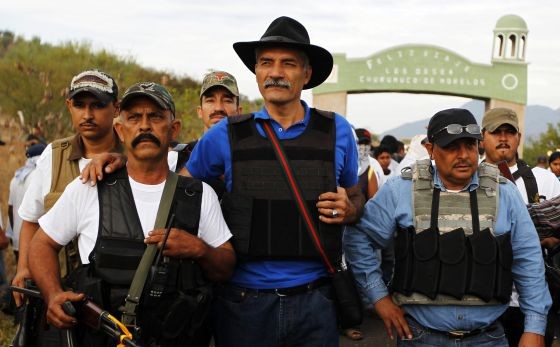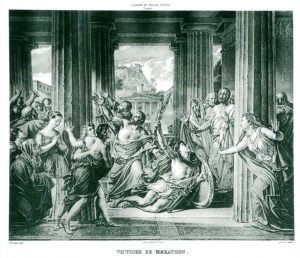It is estimated that, by the 1980s, Mexico’s drug cartels were slowly forming and beginning to operate. By the early 2000s, their presence was increasingly felt through the wave of violence and crime that struck Mexico. This would propel the issue of drug cartels and how to deal with them to the forefront of Mexican public policy. In 2006, newly elected Mexican President Felipe Calderon was faced with stopping the onslaught of violence and crime. Just days into his term, Calderon sent 6,000 Mexican soldiers to the state of Michoacán to combat drug cartels in the area.1 This marked the start of the drug war in Mexico. Almost 12 years later now and the success of the drug war is still questionable. It is estimated that around 50,000 to 70,000 have perished in Calderon’s term alone and to date around 25,000 more have vanished without a trace.2 In some parts of the country, cartels have established themselves as the sole authority there.3 Facing record levels of crime and violence, some citizens in Michoacán have taken action into their own hands by forming self-defense forces.

The development of self-defense forces in Michoacán culminated from many factors. Michoacán is a central state in Mexico giving it an ideal location to be able to move things all over the country quickly. It is located along the coast, providing the option to export drugs via sea. Its economy is largely based on agricultural and mineral resources. Michoacán is known for cultivating avocados and lemons and for the many precious minerals that are mined in the state.4 These characteristics, unfortunately, make it an ideal location for drug cartels who send their drugs to different parts of Mexico and into the United States. In 2006, the state of Michoacán found itself crippled by drug violence and the state was a battleground for different cartel groups vying for control. Under Calderon’s orders, federal Mexican security forces were to combat the cartels and restore order to regions that were under cartel influence. This only led to violent confrontations between security forces and the cartels which ultimately increased the levels of violence and the death toll. The government was largely ineffective in fighting the cartels due to rampant corruption among officials.5 Overwhelmed and out gunned, the Mexican government went as far as calling on the UN to prevent the flow of high-powered weapons from getting into cartel possession.6

The first self-defense forces to form in Michoacán, formed in the city of La Ruana. Here, farmers were under the constant threat of violence and forced to pay protection money to the cartel. The cartel regulated the local agricultural economy and controlled where the farmers could export their produce and to whom they could sell. Cartels also imposed required payments on produce.7 In one such instance of enforcing control, it is reported that several tons of lemons on their way to be delivered were destroyed. In response to such an act, local farmers and field workers formed the first self-defense group to defend themselves, their land, and their produce. The cartel then cut off the city from receiving supplies in an effort to cripple the resistance. The self-defense group would begin to look for others to come to its aid and break the blockade. 36 other similar groups formed around Michoacán. In Tepalcatepec, after facing similar abuses as in other regions of Michoacán, the local livestock association voted to transform their organization into a self-defense force. Other community leaders around Michoacán were present as well when the various self-defense forces were integrated into one entity. It was then that Jose Manuel Mireles Valverde became a prominent leader of the Michoacán self-defense forces.8 By March of 2013, the movement had grown from around 250 to 600, and some press releases from the self-defense forces claimed they were up to 3,000 strong.9
Jose Manuel Mireles Valverde was a medical doctor. In 2013, he was taken hostage, tortured, and only released after his ransom was paid. During the same time, several members of his family were murdered. His neighbors were beheaded and their heads put on display. Due to his own experience with the cartel, he felt compelled to join and lead the self-defense forcesmed. In Teplacatepec, Mireles’ charisma propelled him through the ranks and he became a leader in the organization and its main spokesperson. Under the leadership of Jose Mireles, the self-defense forces spread to other parts of Michoacán. In his role, Mireles became a national figure of resistance that many loved and others, including the government, despised.10
At their peak, the self-defense forces took control of approximately 30 towns around Michoacán. Eventually, the self-defense forces found themselves mired in controversy. By taking up arms and at times opposing state officials, the federal government cracked down against self-defense forces. Legally speaking, the self-defense forces were in violation of Mexico’s Firearms and Explosions Act by arming themselves and thus faced a legal predicament of establishing themselves as a legitimate group. In addition, they opposed the various cartels and the government because corruption was rampant among government officials who work alongside the cartels. The group refused to lay down their weapons despite threats of imprisonment and to be forcefully disarmed.11 Jose Mireles, was the primary targeted of government actions because of his prominent role. Eventually, he alongside dozens of self-defense forces was arrested. The group’s imprisonment was nothing short of controversial and ultimately displayed the attitude the Mexican government had towards its citizens who were simply trying to restore order in their state. Mireles was imprisoned, and after a public apology, his charges were dropped but he remained in custody for almost 3 years.12

Ultimately, the self-defense forces had to disband and some were absorbed by a newly created police force. After some began to question the leadership of Mireles and Mireles’ imprisonment, there was no longer clear leadership. Mireles’ bodyguard, a man by the name of Estanislao Beltran, who is more popularly known as “Papa Pitufo,” “Papa Smurf,” had also risen among the group and many followed him. The newly created rural police force was a subject of much contention and despite Mireles’ opposition to it, Estanislao Beltran and those who chose to follow him joined the new force. The rural police force operated similar to the self-defense force groups but had its authority come from the government and ultimately was controlled by the government. Other groups disbanded and went back to their normal lives, refusing to join. In Michoacán, this ended the rise of self-defense forces.13
The self-defense forces that formed in the Mexican state of Michoacán, formed out of a need to protect the rights and security guaranteed to all persons that the government could not provide. This group of citizens took it upon themselves to restore law and order, protect themselves, their communities, and their livelihoods. Mireles various times explained that their movement had grown so large because everyone in Michoacán had experienced some sort of pain caused by the cartel. He believed that by trying to secure the basic rights that they are entitled to by their governments and by being supported by the people, that they had legitimacy. They removed corrupt officials who worked with the cartel. They began as rag-and-tag armies that soon developed into a well-armed, efficient fighting force that was able to push the cartels out of areas that the federal forces for years had failed to do.14 Since their inception, they requested the support of the government in their mission and while there was limited coordination between the two, ultimately the government came to oppose them and see their downfall as if they themselves were a cartel.15 In some instances, government forces failed to act entirely as the cartels decimated cities, leaving it up to self-defense forces to protect the people.16 They faced a choice of being institutionalized into the corrupt system that had forced them to take action or remain insubordinate and put into question the legitimacy of the Mexican Government. It was never the mission of the self-defense forces to overthrow or undermine the legitimacy of the government. While they claimed legitimacy by being supported by the people, they tried to step in and fill the role of protector that the Mexican government could not provide. Considering the shortcomings of the Mexican governments, it was not ill-placed to rise up and create these self-defense forces, but by doing so undermined their own legitimacy. But in such a corrupt system how else could they bring about change? It was and continues to be the Mexican government who his culpable of the injustices suffered by, not only the self-defense forces in Michoacán, but by Mexican citizens all over the country who continue to suffer at the hands of vicious drug cartels. The self-defense forces of Michoacán represent a desperate effort ultimately stifled into silence and complacency.
In the past couple of years, there has been a resurgence of violence. Since the dismantlement of the self-defense forces, Michoacán continues to be one of the most violent states in Mexico. Jose Mireles has continued to be a critic of a government for its inability to reestablish law and order in Michoacán and other parts of Mexico. The 2018 election of Andres Manuel Lopez Obrador as Mexico’s new President suggests change and a call to action by Mexican citizens all over the country to end the violence that has plagued them. There will be much anticipation to what his administration will do when his government takes power on December 1st, of this year (2018).
- Antonio Fuentes Diaz and Guillermo Paleta Perez, Violencia y Autodefensas Comunitarias En Michoacan, Mexico, Iconos, Revista de Ciencias Sociales, no. 53 (September 2015), 175. ↵
- Alejandro Rodiles, Law and Violence in the Global South: The Legal Framing of Mexico’s ‘Narco War, Journal of Conflict and Secuirty Law, no. Issue 2: 269. ↵
- Andres Galeana Abarca, Ungoverned Spaces in Mexico: Autodefensas, Failed States, and the War on Drugs in Michoacan, (2014), 13-19. ↵
- Antonio Fuentes Diaz and Guillermo Paleta Perez, Violencia y Autodefensas Comunitarias En Michoacán, Mexico, Iconos, Revista de Ciencias Sociales, no. 53 (September 2015), 175-176. ↵
- Antonio Fuentes Diaz and Guillermo Paleta Perez, Violencia y Autodefensas Comunitarias En Michoacán, Mexico, Iconos, Revista de Ciencias Sociales, no. 53 (September 2015), 174. ↵
- “Mexico Calls on UN to Help Control Flow of High-Powered Weapons to Drug Gangs,” UN News, (September 2011). ↵
- Enrique Guerra Manzo, Las Autodefensas de Michoacán, Politica y Cultura, no. 44 (October 2015), 16. ↵
- Antonio Fuentes-Diaz, Narcotráfico y Autodefensa Comunitaria En Tierra Caliente, Michoacán, México / Drug Trafficking and Community Self-Defense in Tierra Caliente, Michoacán, Mexico, CiencaUAT, (Universidad Autonoma de Tamaulipas, 2015), 76-77. ↵
- Enrique Guerra Manzo, Las Autodefensas de Michoacán, Politica y Cultura, no. 44 (October 2015), 13. ↵
- Matthew Heineman, Tom Yellin, Jose Mireles, and Tim Foley, Cartel Land, (Hollywood, California) Paramount Pictures, (2016). ↵
- Matthew Heineman, Tom Yellin, Jose Mireles, and Tim Foley, Cartel Land, (Hollywood, California): Paramount Pictures, (2016). ↵
- Maria Verza, “Mexican Judge Grants Vigilante Leader’s Release on Bond,” AP English Worldstream- English, Associated Press DBA Press Association (May 2017). ↵
- Enrique Guerra Manzo, Las Autodefensas de Michocacan, Politica y Cultura, no. 44 (October 2015), 17. ↵
- Matthew Heineman, Tom Yellin, Jose Mireles, and Tim Foley, Cartel Land, (Hollywood, California) Paramount Pictures, (2016). ↵
- Enrique Guerra Manzo, Las Autodefensas de Michoacán, Politica y Cultura, no. 44 (October 2015), 17. ↵
- Enrique Guerra Manzo, Las Autodefensas de Michoacán, Politica y Cultura, no. 44 (October 2015), 21. ↵



54 comments
Jacqueline Mendez
This article hits home. I experienced cartel crime and violence first hand and it truly saddens me. But I love how reading this article its talked about. I believe that these types of articles should be written to remember the lives lost during this first war of cartels. I call it a war because that’s what it was. The uprising of these cartels in the 80s was that seed that was planted to grow into a ginormous tree with its branches somehow tangled to every citizen in Mexico.
Kasandra Ramirez Ferrer
As a Mexican citizen, it saddens me to get to know these events and how this constant drug cartel issue still affecting Mexico at the point that has changed the country’s government itself. What the self-defense forces did is a fine example of how Latinos call of help that was not answered and ended up making Michoacan’s population take action in their hand to make their streets safe. These people were trying to keep their families safe and accomplishing what the government’s forces could not for years. Mexicos drug cartel problem won’t be fixed until people like the self-defense forces take action in the government to make Mexico the great country it once was.
Mariana Beltran
This is a very relevant topic, not only in the Latin American world, but also in our St. Mary’s community. I have encountered many classmates who’s lives where radically changed due to the violent actions between opposing cartels. Many have lost a parent, a sibling, or a friend. But other than losing a loved one, they lost the feeling of safety, the security that they are free from hard. They lived in constant fear waiting for the next attack. I believe it was right of the civil to take arms in order to protect them selves and their families. The government should further contribute to the safety of their citizens.
Eric Ortega Rodriguez
This article is fascinating and I love that I am reading this now, especially since now Andres Manuel Lopez Obrador is in office. I look forward to seeing what approach he takes in order to reestablish the law. As for the citizens of Michoacán, I believe they have every right to defend themselves especially when the government does not seem to do anything for Mexico’s people. Overall, this was a great read. Good work.
Nadia Carrasco
I surprisingly really enjoyed this article. The Mexican government has always had a sad reality of problems with authority. The citizens of Mexico feel so defenseless and unprotected by the police force it forces people to take things into their own hands just to survive. It is such a harsh reality these people go through on a daily basis. For me, this article did a great job of making these stories come to life.
Antonio Coffee
I find the story of these men to be incredibly interesting. It brings me joy to know that there are people out there that are willing to stand up for what they believe in, in order to protect their communities. These men that made up the self-defense forces are probably braver than I am. They not only opposed the cartels but also had to break the law to do so. While they ultimately were shut down, they put so much on the line to ensure that their homes were safe.
Aracely Ortiz Soriano
I definitely believe that the citizens of Michoacan should have the right to have self-defense forces. It is a harsh condition these people are living in, and one of constant panic it would not hurt for these citizens to look after themselves, seeing that the Mexican government is unable to do so and even if they think they do, at the end of the day the citizen’s lives are the ones on the line, not the government’s.
Joshua Garza
this is a pretty cool article. I like the whole idea of vigilantism in this certain scenario where law enforcement does not protect the people against the terrors of organized crime and illegal taxation. I saw a news article about this once and it made me proud of these people to do such a brave thing for themselves and not wait for help they will never get. They are their own protectors and that is cool.
Avery Mascorro
I thought it was interesting that the newly elected Calderon had so many casualties under his presidency. Those are such huge numbers in to the hundred thousands that should be terrifying to the public. Putting that fact at the beginning of the article was really effective to me.
Mariah Garcia
It is said that there is a resurgence of violence since the dismantlement of self defense forces. That alone should spark the government to give the citizens the right to have a self-defense forces because they will be able to feel safer than they do now. I can’t imagine living in such a harsh condition where you have to sleep with one eye open. It is scary, but sadly it is reality for the people in Michoacán. I agree that should be able to arm themselves because the cartels are heavily armed. So, I think the citizens arming themselves is for safety and protection. If they could push the cartel out once, they can do it again and I think the government shouldn’t have a say because it is not their lives on the line.